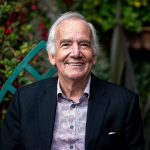Systemic Coaching: Coaches explore connection to imagine a sustainable future
Globalization and technological innovation are rapidly transforming policy, business, and the environment. Systemic coaching aims to meet complex and changing client needs with a future focus.
Wisdom Weaver
Coaching to address global complexity and the future of human development
Today’s leaders face a record rate of change and complexity. Technological innovation and automation are replacing jobs, educators are tasked with preparing students for careers that do not yet exist, and disruptions in one country can have devastating consequences on the global economy. For coaches to support clients in navigating the future of work, they will need to understand how interconnected systems are transforming the rate and degree of change.
When Wisdom Weavers Dr. Peter Hawkins and Eve Turner wrote Systemic Coaching, published by Routledge in 2019, they wanted to engage coaches in a conversation around the questions, “how can coaching deliver value beyond the individual” and “how does coaching need to disrupt itself to meet the challenges of the next thirty years?” To be future-fit, the authors investigate how current coaching practices struggle to meet changing client needs. They cite how new regulations and social expectations mean business leaders balance shareholders’ needs with social and environmental impact. Coaching must go beyond 1:1 leadership development and expand to meet the needs of a client’s stakeholders.
Among these stakeholders, coaches will also need to consider how clients relate to the non-human world of the environment. Beyond environmental regulation and carbon neutrality goals, human civilization depends on finite natural resources already being used beyond the planet’s capacity to regenerate. Peter describes how issues related to resource management, climate change, pollution, natural disasters, and biodiversity loss “are interconnected issues—none of which we can solve by themselves. At the heart of all those issues is that they are caused by the way we, as humans, think and operate.”
Measuring coaching impact and legacy
For coaches to help clients address complex social and environmental issues, Peter asserts “the most urgent task is how we shift human thinking. I see coaches, along with many other professionals, including educators, spiritual teachers, and therapists, as all in the business of ‘how do we shape human consciousness?’ Part of this “shaping” involves taking a long-term perspective toward impact. Coaches already work with individuals, teams, and organizations; what potential is there for coaches to expand these frameworks to communities and human development on a global scale?
“How do you start coaching systemically? How do you start a new relationship system?”

Peter shares how conversations with other coaches helped him to look at the legacy of his own practice. When coaches support the efficiency and profitability of corporations, what responsibility do they have for corrupt client practices such as exploitation or resource mismanagement? Peter reflects that at this point in his career, he has the privilege to choose his clients. “Today I only work with organizations who, I am confident, are making the world a better place for the lives of my grandchildren.” Beyond his personal practice, Peter hopes that the collective of coaching professionals can work towards supporting social equity and extended human development. He explains, “rather than seeing coaching as very expensive personal development for the already highly privileged, I’ve spent the last 12 years trying to ask, ‘How do we shift that?’”
Interview with Professor Peter Hawkins on systemic coaching and the future of planetary ecology
How does systemic coaching differ from traditional coaching relationships?
“We are stuck with a very old-fashioned paradigm about coaching that the client is the person sitting opposite you. That’s true if the client who is sitting across from you is the one who is paying you. But, if it’s business, executive coaching, or leadership coaching, the person sitting opposite of you is your coaching partner. They might be the coachee, but they’re not the client.”

What does this type of coaching relationship look like, and how does it serve the greater coaching client?
“What you’re doing, shoulder to shoulder, is you’re looking at: ‘how together do we address the needs of the coachee’s stakeholders and ecosystem?’ Not, ‘what do you want from coaching?’ But ‘what is life knocking on your door requiring you to step up to?’ By life, I mean, ‘what is your organization, your team, the people you lead, the investors, the customers, communities that you operate within, and the ecology requiring of you?’ Those are all stakeholder groups. They are going to need different things in the future.”

As some coaches wrestle with their role in addressing environmental topics through their practice, how do you bring ecology into coaching conversations?
“How do we bring the ecology into coaching? My answer is you don’t. The ecology is already there. It’s just that you’re not paying attention to it. Do your clients breathe? Do they eat? If they breathe, then the ecology is already in the room. So then, how do we pay attention to it? You don’t bring it in as a coach as an agenda item.”

How does systemic coaching bring awareness to what is already in the room?
“I teach this to many coaches and team coaches. The first question is, ‘tell me in 2 minutes the story of your life, from the moment you were born to the moment of arriving in this room, in a way you’ve never said it before.’ It’s extraordinary because you get a very different sense of the person than if they just told me their CV…And then I ask, ‘take me to a time in the last year of work that made you feel absolutely passionate about what you were doing?’ Depending on the culture or the context, I’m tuning into where their passion is, where their heart is.”

Can you explain how these passions reveal systemic coaching goals?
“In the next ten questions or so, I ask them whom does their work serve. When they tell me about their family, I ask, ‘who else?’ And they tell me about the team they lead, their boss, the organization, and teams upstream and the teams downstream. And I ask, ‘who else? What about beyond the organization?’ Who are their stakeholders?
They might say, ‘what do you mean by stakeholders?’
There are at least six we have to think about, which are: employees, investors, customers, suppliers and partner organizations, communities where we operate, and the wider, more-than-human world of the ecology. I invite them to bring all those stakeholder groups into the room with them, and I ask, ‘what would they be saying is the work you and I need to be doing together?’”

What is the impact of including all six stakeholder groups?
What we have found, both from the research and from all the people we’ve talked to in the Climate Coaching Alliance, is that if you don’t bring in all the stakeholders in the first meeting, it becomes harder to bring them in. If they’re part of the coaching frame, It’s not a problem. If you’re doing leadership coaching or executive coaching, you need to be delivering value for all six stakeholder groups of your coachee, and that’s ultimately where we have to do the internal investment. A high-value-creating team is one that continuously co-creates beneficial value with and for all its stakeholders. So systemic, high-value creation coaching is coaching that co-creates with and for and through the coachee, for all the coachee’s six stakeholder grouping.”

How does systemic coaching create value for the coachee and their stakeholder groups?
“If you are not creating value with and for each stakeholder group, you are not going to have a sustainable organization. So, if I’m not helping you create value with and for all your stakeholders, I am letting you down as a person. If you say, ‘well, I only want to focus on maximizing profit for the shareholders,’ how do you do that and retain your employees? How do you do that if you don’t delight your customers? What about your customer’s customer? And in the communities you operate, you need to partner and have the license to be there. If you end up in a scandal with your local city or country, you’re in dead water. And if you’re not creating a sustainable ecology, please remember every organization is a wholly owned subsidiary of the ecology, and the ecology can shut any of us down.”

You relate sustainability to meeting the future needs of each stakeholder. How do leaders balance organizational needs with other stakeholders to stay future-fit?
“If the individual’s agenda is not the agenda of the world around them, they’ve got problems. And I’m not going to be helping them. Anybody who tries to sub-optimize their bit of the system at the cost of what’s around them may get some short-term benefit, but it’s setting up extraordinary long-term problems for themselves.”

And how does this framing extend to ecological sustainability?
“If you’re working within a systemic paradigm, [there is no] issue about bringing the ecology into the room. It’s not that it doesn’t exist as an issue, it happens because you and your ecology are not separate. You don’t exist without your ecology. The challenge is in the connection. That’s another part of systemic coaching. Every time [the coachee] brings up a problem, you reframe it as a challenge. Step two is you locate the challenge, not in a person or a part of the system, but it’s in the connection that the person is part of.”

What challenges do coaches face when trying to coach with and for the connected systems of stakeholders?
“One of the things we teach a lot about systemic team coaching is your capacity is much wider than what it is for individual coaching. You have to be able to create rapport with everybody in the room but focus on the collective and not get caught in serving the needs of individuals. You have to be able to listen to not just all the individuals but what’s the collective saying and listen through the team. So how they’re enacting the organizational culture, and then listen through the organization to the stakeholders beyond. That’s a lot of capacities. But what we find, of course, is we can teach people systemic thinking, you can teach people ‘systemic doing’ through all sorts of tools, but ‘systemic being’ takes far longer to develop.”
I say philosophically or systemically, there is no such thing as individual coaching. There is coaching with an individual or through an individual right. One of the other paradigms which I challenge is the notion that the coach does the coaching. It’s an extraordinarily powerful belief system within coaching. It’s a very arrogant belief system. Rather, the coaching is done jointly by the coach, the coachee, and the curriculum that life is providing. Those three elements do the coaching. The most important is the curriculum that life is providing. We need to look at this paradigm that coaching is done by the coach, which is very individualistic and arrogant.”

You mention challenging paradigms. Looking to the future, what needs to develop in the coaching profession for coaches to take a systemic approach?
I wrote a piece called “Cracking the Shell” about the 7 things they would have taught you in your coach training that you have to unlearn to work systemically. I think that one of the things we need to have climate-conscious coaching and ecological-conscious coaching is to unlearn that there is such a thing as an individual that exists separate from all the embedded relationships they’re part of. That’s quite hard for a number of coaches, and it’s particularly hard for American coaches compared to when I am teaching in China, Japan, Singapore, and Southeast Asia. To really shift coaches, to be able to have an impact on the climate ecology, there’s a whole ecological educational process that is much about shifting the belief systems we have created. We can’t solve those problems with the thinking that created them.”





